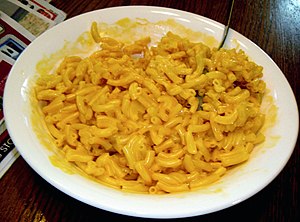Cookbook:Macaroni and Cheese
| Macaroni and Cheese | |
|---|---|
 |
Cookbook | Recipes | Ingredients | Equipment | Techniques | Cookbook Disambiguation Pages
Macaroni and cheese is a dish combining pasta (usually macaroni) with cheese or a cheese-based sauce. It can be made by tossing cooked pasta in a cheesy white sauce or made as a baked casserole.
Sauce
editThe cheese sauce used in macaroni and cheese is generally a variant on Sauce Mornay, a French sauce consisting of Bechamel sauce with added cheese. The sauce can be heavily customized so long as the liquid ingredients do not exceed the capacity of the roux to thicken it to a usable consistency. Common additions include white pepper or hot mustard, but Worcestershire sauce or even diluted tomato paste can make interesting additions. Fresh herbs should be left until the end of the recipe, while dried herbs will soften nicely in the cheese sauce. Other possibilities for experimentation involve replacing some of the milk with other liquids, with beer and stock being two avenues of exploration. Of course, the most obvious change one can make is in the types of cheese.
The cheeses used in the sauce may be of any sort, but one should keep in mind that at least some of the cheese should be sharp-tasting (lest the sauce be bland) and that some cheeses melt very well (soft bleu, gruyere, cheddar) while others do not (e.g. feta). The most common mixture in American macaroni and cheese is Parmesan and cheddar, with aged cheddar providing a more assertive flavour that some children may dislike.
Packaged mixes use a highly processed sauce based on milk ingredients alongside a large amount of citric acid, which is responsible for both the pronounced sharpness of commercial cheese sauce ("Nacho Cheese") as well as its distinctive texture. This can be done at home by melting one or more cheeses into a solution of a liquid (commonly water, beer or stock) with 1 teaspoon of sodium citrate, available at large markets as 'sour salt.'